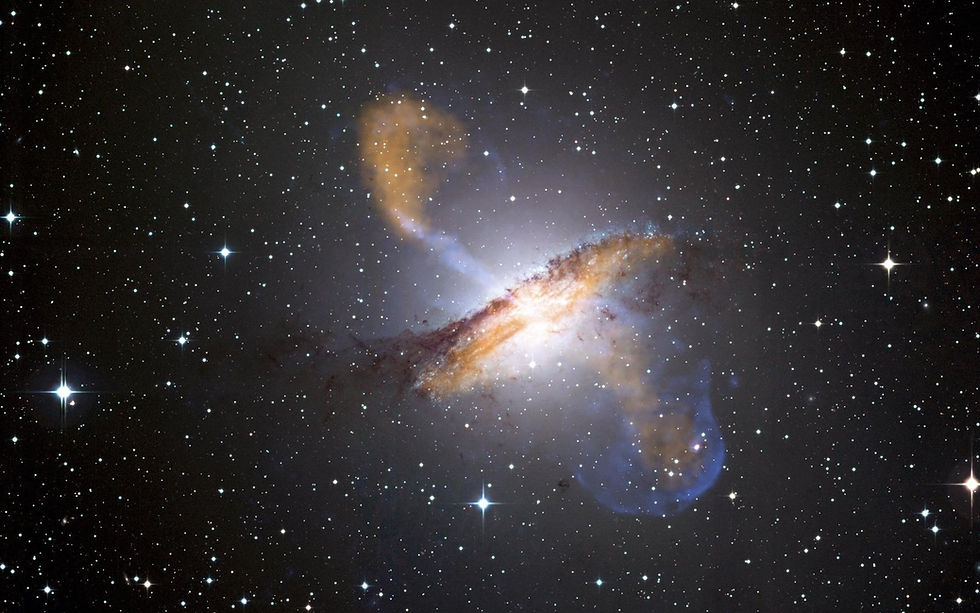Unraveling the Mysteries of Black Holes: A Comprehensive Study on Their Formation
- Dhruv Hegde
- Aug 5, 2023
- 5 min read
Author: Afreen Hossain - Astronomy Cohort - August 5th, 2023

Abstract
Black holes have captivated the imaginations of scientists and the general public alike for decades. These enigmatic celestial objects, characterised by their immense gravitational pull and ability to trap even light, have remained a subject of intense scientific study and fascination. This article delves into the world of black holes, discussing their formation properties and influence on the cosmos.
BLACK HOLES
The concept of black holes dates back to the early 20th century, when Albert Einstein's theory of general relativity revolutionized our understanding of gravity. Black holes are regions in space where gravity is so intense that nothing, not even light, can escape their grasp. While they were initially considered mere theoretical curiosities, evidence from observations and simulations in recent decades has confirmed their existence and unveiled their many mysteries.
When massive stars exhaust their nuclear fuel and explode in a supernova, the star's core collapses under the force of gravity, becoming the most frequent type of black hole. This disastrous occurrence results in a dense, compact object known as a black hole. The mass of a black hole can range from a few times that of the Sun to several tons of solar masses. Another class of black holes called supermassive black holes reside at the centers of most galaxies, including our Milky Way. These giants have masses ranging from millions to billions of times that of the sun. The origin of supermassive black holes remains a topic of ongoing research, with multiple theoretical scenarios proposed.
A black hole's event horizon, a line beyond which nothing can escape, is what sets it apart. Once an item passes this line, it is inescapably sucked into the interior of the black hole. the singularity The center region of the black hole is enclosed by this event horizon, an invisible surface. As far as our current understanding of the rules of physics is concerned, the singularity is a region of infinite density.
Black holes themselves do not emit light, making them nearly impossible to observe directly. However, scientists have developed various techniques to indirectly detect and study black holes. One such technique is studying the effects of black holes on nearby objects such as stars or gas clouds. The gravitational interactions between black holes and their surroundings can leave distinctive signatures that can be observed from Earth. Recent advancements in technology, such as the event horizon telescope, have enabled us to capture the first-ever images of black holes. In 2019, the event horizon telescope unveiled the image of the supermassive black hole at the center of the galaxy, m87, providing
valuable insights into the nature of these cosmic enigmas.
Scientists have obtained the first image of a black hole, using Event Horizon Telescope observations of the center of the galaxy M87. The image shows a bright ring formed as light bends in the intense gravity around a black hole that is 6.5 billion times more massive than the Sun. Image credit: Event Horizon Telescope Collaboration

Photo by Dan Cristian Pădureț
Black holes are a unique realm where the laws of general relativity and quantum mechanics intertwine. Understanding the behavior of black holes requires reconciling these two fundamental theories, a task that has proven to be one of the greatest challenges in theoretical physics. Researchers have made significant progress in understanding black holes. Physics with breakthroughs like Hawking radiation, proposed by Stephen Hawking in the 1970s, suggests that black holes can emit radiation due to quantum effects near their event horizons. This radiation gradually depletes a black hole's mass over time, eventually leading to its evaporation — a phenomenon referred to as “Hawking evaporation”.
The statement that black holes are a unique realm where the laws of general relativity and quantum mechanics intertwine reflects a fundamental problem in modern physics. General relativity, formulated by Albert Einstein in the early 20th century, describes the force of gravity as the curvature of spacetime caused by massive objects. It has been incredibly successful in explaining the motion of planets, the bending of light, and even the expansion of the universe.
On the other hand, quantum mechanics is the branch of physics that deals with the behavior of particles at the smallest scales, such as atoms and subatomic particles. It has been exceptionally successful in explaining the behavior of particles and forces at these tiny scales. Both general relativity and quantum mechanics are incredibly accurate and have been extensively tested and confirmed through experiments and observations in their respective domains. However, when we try to apply these theories to extreme conditions such as those found in black holes, they produce conflicting predictions. This conflict arises because general relativity and quantum mechanics appear to be incompatible when it comes to understanding the physics of black holes. In the realm of black holes, the curvature of spacetime becomes extremely strong due to the immense mass of the black hole concentrated in a small region.
At the center of a black hole lies the singularity. A point of infinite density where our understanding of physics breaks down. Herein lies the crux of the problem. General relativity fails to describe what happens at the singularity since it predicts a breakdown in the laws of physics. On the other hand, quantum mechanics operates at these incredibly small scales, and when applied to black holes, it predicts that particles can be created and destroyed around the event horizon, resulting in Hawking radiation. Hawking radiation, proposed by Stephen Hawking in 1974, is a phenomenon where black holes are thought to emit radiation due to quantum effects near their event horizons. This radiation causes black holes to gradually lose mass over time and eventually evaporate. However, the idea of information loss in black hole evaporation has led to the information paradox as it seems to contradict the principles of quantum mechanics that state that information cannot be destroyed.
The reconciliation of general relativity and quantum mechanics in the context of black holes is a monumental challenge known as the quantum gravity problem or the theory of quantum gravity. Many physicists believe that finding a unified theory that combines these two theories is crucial to our understanding of the fundamental workings of the universe especially in extreme conditions like those found near black holes and during the early moments of the big bang various approaches have been proposed to tackle this challenge such as string theory loop quantum gravity and others but no consensus has been reached yet these theories attempt to extend our understanding of both general relativity and quantum mechanics into a unified framework that can describe the behaviour of matter and gravity at all scales including the realm of black holes.
References:
.png)






Comments